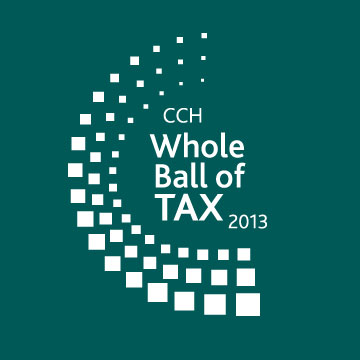| Home | About Us | Order Products | Press Center | Customer Service | Career Opportunities |

CCH can assist you with stories, including interviews with CCH subject experts.
Also, the 2013 Visit the CCH Whole Ball of Tax site often as new releases and other updates will be posted CCH provides special CCH Tax Briefings on key topics at CCHGroup.com/Legislation.
|
The Modern Income Tax Turns 100: CCH Takes a Look Back...and AheadTax Law Makeover May Be in Store
|
||||||||||||||||||||||||||||||||||||||||||||||||||||||||||||||||||||||
1913 Nominal Rate |
1913 Adjusted for Inflation to Today |
||
Tax Rate |
Tax Brackets |
Tax Rate |
Tax Brackets* |
1.0% |
$0 to $20,000 |
1.0% |
$0 to $463,826 |
2.0% |
$20,000 to $50,000 |
2.0% |
$463,826 to $1,159,566 |
3.0% |
$50,000 to $75,000 |
3.0% |
$1,159,566 to $1,739,348 |
4.0% |
$75,000 to $100,000 |
4.0% |
$1,739,348 to $2,319,131 |
5.0% |
$100,000 to $250,000 |
5.0% |
$2,319,131to $5,797,828 |
6.0% |
$250,000 to $500,000 |
6.0% |
$5,797,828 to $11,682,677 |
7.0% |
$500,000 and more |
7.0% |
$11,595,657 and more |
* Inflation-adjusted amounts are rounded to the nearest dollar.
Fast forward to 2013, and the tax brackets in affect for most taxpayers are:
2013 Tax Rates & Brackets
Tax Rate |
2013 Taxable Income |
|
|
Single Filers |
Married Joint Filers |
10.0% |
$0 to $8,925 |
$0 to $17,850 |
15.0% |
$8,925 to $36,250 |
$17,850 to $72,500 |
25.0% |
$36,250 to $87,850 |
$72,500 to $146,400 |
28.0% |
$87,850 to $183,250 |
$146,400 to $223,050 |
33.0% |
$183,250 to $398,350 |
$223,050 to $398,350 |
35.0% |
$398,350 to $400,000 |
$398,350 to $450,000 |
39.6% |
$400,000 and up |
$450,000 and up |
While 2013 rates are considerably higher than 100 years ago – and some people are feeling the effects of income tax increases under the American Taxpayer Relief Act of 2012 (ATRA) – the 2013 rates are still significantly lower than the all-time high income tax rates experienced in the mid-20th century.
“As the U.S. ramped up for World War II, the tax rate for the highest income earners reached 94 percent, and while rates went down slightly after the war, the highest tax bracket remained at more than 90 percent until the Tax Reform Act of 1964,” said Luscombe.
Even then, tax rates for the highest earners remained at 70 percent or more until the 1980s. (For more information on income tax rates, see Release 29: A Historical Look at Top Marginal Income Tax Rates.)
Tax Exemptions from the Start
The income tax of 1913 taxed all sources of income from all Americans, whether they were living in in the United States or abroad. The income of resident aliens and U.S. income of non-residents also was taxed. Individuals could subtract a fixed amount of $3,000 per person plus an extra $1,000 for married couples in figuring their taxable income. As with today, taxpayers in 1913 also could take deductions and were allowed exemptions for certain items, including:
- Deducting interest, such as mortgage interest. The mortgage interest deductions also was allowed in recent years;
- Deductions for nearly all state and local taxes. In recent years, taxpayers could choose to claim an itemized deduction for state and local sales taxes in lieu of state and local income tax. That was set to expire after 2011, but the ATRA has extended it through 2013;
- Deductions for casualty losses due to “fire, storms or shipwreck and not compensated for by insurance.” Certain casualty losses also are deductible today;
- Deductions for excise tax on telephone service. Today, this is not deductible;
- Exemptions for state and local bond interest. This also can be exempt today; and
- Exemptions for U.S. bonds. This is now taxable.
Also, there were no special tax rates for capital gains and dividends in 1913. Rather, they were taxed like all other income. However, the highest tax rate in 1913 was 7 percent. Had the ATRA not passed, dividends would again have been taxed at ordinary income tax rates as of 2013; however, under the ATRA, the maximum rate for both capital gains and dividends is 20 percent, up from 15 percent in 2012. In addition investors are subject to a 3.8-percent Medicare contribution tax on investment income.
Will Taxes Ever Be Simple?
While several efforts have been made to simplify and streamline taxes over the years, the size of the tax code has progressively increased. For a history on this, see the fact sheet below. For example, there have been nearly 5,000 changes to the tax code since 2001, an average of more than one a day, according to the National Taxpayer Advocate’s 2012 Annual Report to Congress.
And while taxes have increased for 2013, there are still a considerable number of popular tax credits and deductions – all of which need explaining; for example, deductions for higher education and retirement savings; and credits for such things as dependent care.
“It’s not likely the tax code will ever be simple, but tax reform could make it much less complex,” said Luscombe. “Whereas just a few years ago it was still conceivable for many people to figure out their taxes on their own, it’s becoming increasingly risky for most people to try to do their taxes without the help of a tax preparer or tax preparation software.”
On the flipside, for students looking at a potential career – being a tax professional is well worth considering and is forecasted to see double-digit growth through 2020.
“Even with tax reform, taxes will always be around; most people don’t like dealing with them, but for those who find it interesting, there will always be taxpayers who need help understanding and complying with tax rules,” said Luscombe.
About CCH, a Wolters Kluwer business
CCH, a Wolters Kluwer business (CCHGroup.com) is a leading global provider of tax, accounting and audit information, software and services. Celebrating its 100th anniversary in 2013, CCH has served tax, accounting and business professionals since 1913. Among its market-leading solutions are the ProSystem fx® Suite, CCH Integrator™, CCH® IntelliConnect®, Accounting Research Manager® and the U.S. Master Tax Guide®. CCH is based in Riverwoods, Ill. Follow us on Twitter @CCHMediaHelp. Wolters Kluwer (www.wolterskluwer.com) is a market-leading global information services company. Wolters Kluwer is headquartered in Alphen aan den Rijn, the Netherlands. Its shares are quoted on Euronext Amsterdam (WKL) and are included in the AEX and Euronext 100 indices.
-- ### --
nb-13-36

FACT SHEET
100-Year Tax History: The Length and Legacy of Tax Law
In the 100 years since the creation of the modern income tax, there have been many law changes, from major reform to ongoing tweaks. The result?
For CCH, what began in 1913 as a 400-page legal information service stands today as a 73,954 page, 25-volume service called CCH Standard Federal Tax Reporter, containing the federal tax law and related materials. CCH also now makes it fully available online and via mobile devices. (See how the Standard Federal Tax Reporter has grown in size here.)
Federal Tax Law Background
Federal tax law basically begins with the Internal Revenue Code (IRC). Today, Title 26 of the United States Code contains most federal tax laws and is known as the Internal Revenue Code.
What’s now known as the federal tax law began with passage of the United States Revenue Act of 1913, also known as the Underwood Tariff Act. It was signed into law by President Woodrow Wilson on October 3, 1913 – eight months after the Sixteenth Amendment to the U.S. Constitution was ratified on February 3, 1913, which allowed for the federal income tax. The income tax was aimed at collecting revenue that many feared would drop due to newly reduced tariff duties.
The text of the Sixteenth Amendment, combined with the text of the United States Revenue Act of 1913, is generally considered to be the original tax code. Combined, these documents were approximately 27 pages in length, and the pages measured six by nine inches.
The Internal Revenue Code
CCH publishes the IRC and consistently updates the Code to reflect legislative changes. Twice each year, CCH publishes the text of the current Internal Revenue Code, with brief amendment notes that specifically identify changes made by Acts of Congress. Although this publication contains a table of contents, index and historical footnotes, it does not contain the additional information found in the Standard Federal Tax Reporter such as Committee Reports, regulations, explanations, annotations or new matters. (See below.)
CCH’s most recent edition, the 2013 Winter Edition of the U.S. Internal Revenue Code contains 5,248 pages. It is also printed on the six by nine inch paper that the text of the Sixteenth Amendment and Revenue Act of 1913 were published on 100 years ago.
It’s important to note that unlike information service providers such as CCH, the government does not publish a stand-alone Internal Revenue Code separate from Title 26 of the United States Code.
Page count summary:
- 1913 tax law: estimated 27 pages; and
- 2013 CCH Winter Edition of the United States Internal Revenue Code: 5,248 pages.
CCH Standard Federal Tax Reporter
Following the ratification of the Sixteenth Amendment and passage of the Revenue Act of 1913, the Income Tax Service was published by a forerunner of CCH. The original loose-leaf volume contained the text of the Sixteenth Amendment and Revenue Act of 1913, as well as related regulations, rulings, official opinions, judicial decisions and forms. In its first year, this service grew to 400 pages. And it’s never stopped growing!
Over the years, the service became known as the CCH Standard Federal Tax Reporter, which in print is now a 25-volume set of binders filled with 73,954 loose-leaf pages. It is now available online and via mobile devices through CCH’s IntelliConnect platform. This online, cumulative, comprehensive, running record of all changes and additions to federal tax laws is kept updated by CCH.
Today, the CCH Standard Federal Tax Reporter contains the text of the income tax provisions of the current Internal Revenue Code; excerpts of relevant Committee Reports that explain the intent of Congress with respect to specific law changes; regulations; explanations; annotations or brief descriptions of agency guidance and judicial opinions; new matters and specific finding devices. A graph showing the history of how the Standard Federal Tax Reporter has grown in size can be viewed here.
Page count summary:
- 1913 Income Tax Service (text of income tax amendments to the Constitution and Income Tax Act of 1913, plus regulations, rulings, official opinions, judicial decisions and forms) – 400 pages; and
- 2013 CCH Standard Federal Tax Reporter (text of the income tax provisions of the Internal Revenue Code, regulations, explanations, annotations and more) – 73,954 pages.
Factors such as font size, word spacing and margin widths also must be taken into consideration when comparing how the original 1913 text has expanded into the current version.
Source: Wolters Kluwer, CCH: 2013
© 2024, CCH INCORPORATED. All rights reserved. |
Back to Top | Print this Page | ||||||||||||||||||